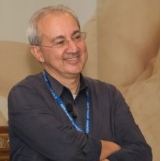Selected Papers from The 13th Conference on Atomically Controlled Surfaces, Interfaces and Nanostructures (ACSIN 2016)
A special issue of Condensed Matter (ISSN 2410-3896).
Deadline for manuscript submissions: closed (10 November 2016) | Viewed by 78945
Special Issue Editors
2. CNR - Istituto Struttura della Materia and Elettra-Sincrotrone Trieste, Basovizza Area Science Park, 34149 Trieste, Italy
3. RICMASS - Rome International Center for Materials Science – Superstripes, Via dei Sabelli 119A, 00185 Roma, Italy
Interests: correlation phenomena in X-ray absorption spectroscopy; X-ray absorption in elements of geophysical interest; dust and aerosol characterization; ultra-trace detection for indoor and outdoor environmental studies
Special Issues, Collections and Topics in MDPI journals
Interests: synchrotron radiation research; protein fluctuations; active sites of metalloproteins; origin of life; selected molecules in prebiotic world; quantum phenomena in complex matter; quantum confinement; superstripes in complex matter; lattice complexity in transition metal oxides; high Tc superconductors; valence fluctuation materials
Special Issues, Collections and Topics in MDPI journals
Special Issue Information
This special issue will publish selected papers from the ACSIN 2016 conference, 9-15 October 2016 in Rome, Italy. Submissions should be received before the start of the conference and will be rapidly reviewed during or shortly after the conference.
The year 2016 will mark the 27th anniversary of the ACSIN series and it will happen in Rome at the Bruno Touschek Congress Center of Laboratori Nazionali di Frascati - Istituto Nazionale di Fisica Nucleare. The first International Symposium on Atomically Controlled Surfaces and Interfaces was held in 1991 – Tokyo, supported by the Thin Film and Surface Physics Division in The Japan Society of Applied Physics in commemoration of its 20th anniversary. Bearing in mind the developments in nanoscience and nanotechnology, the word “Nanostructures” has been added to the name of the conference since the fifth International Conference on Atomically Controlled Surfaces, Interfaces and Nanostructures (ACSIN-5) was held in Aix-en Provence in 1999. Following the successful series of ACSIN conferences in Tokyo (ACSIN-9, 2007), Granada (ACSIN-10, 2009), Saint Petersburg (ACSIN-11, 2011), and Tsukuba (ACSIN-12, 2013).

Manuscript Submission Information
Manuscripts should be submitted online at www.mdpi.com by registering and logging in to this website. Once you are registered, click here to go to the submission form. Manuscripts can be submitted until the deadline. All submissions that pass pre-check are peer-reviewed. Accepted papers will be published continuously in the journal (as soon as accepted) and will be listed together on the special issue website. Research articles, review articles as well as short communications are invited. For planned papers, a title and short abstract (about 250 words) can be sent to the Editorial Office for assessment.
Submitted manuscripts should not have been published previously, nor be under consideration for publication elsewhere (except conference proceedings papers). All manuscripts are thoroughly refereed through a single-blind peer-review process. A guide for authors and other relevant information for submission of manuscripts is available on the Instructions for Authors page. Condensed Matter is an international peer-reviewed open access quarterly journal published by MDPI.
Please visit the Instructions for Authors page before submitting a manuscript. The Article Processing Charge (APC) for publication in this open access journal is 1600 CHF (Swiss Francs). Submitted papers should be well formatted and use good English. Authors may use MDPI's English editing service prior to publication or during author revisions.
Benefits of Publishing in a Special Issue
- Ease of navigation: Grouping papers by topic helps scholars navigate broad scope journals more efficiently.
- Greater discoverability: Special Issues support the reach and impact of scientific research. Articles in Special Issues are more discoverable and cited more frequently.
- Expansion of research network: Special Issues facilitate connections among authors, fostering scientific collaborations.
- External promotion: Articles in Special Issues are often promoted through the journal's social media, increasing their visibility.
- Reprint: MDPI Books provides the opportunity to republish successful Special Issues in book format, both online and in print.
Further information on MDPI's Special Issue policies can be found here.






